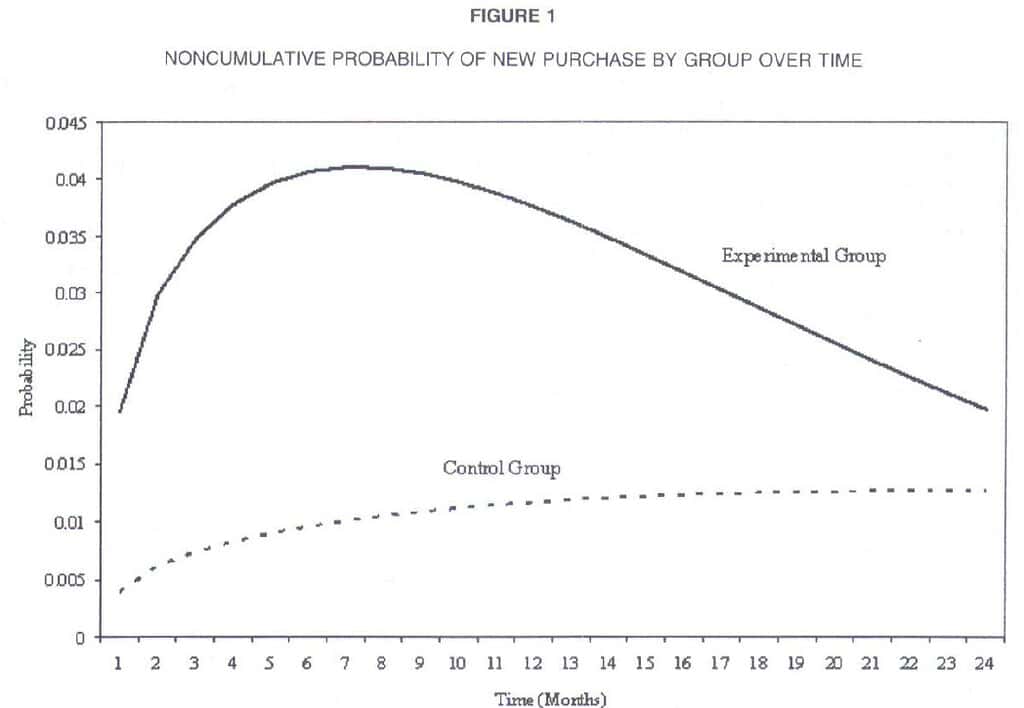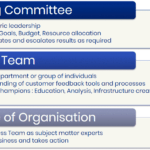More people nominate “Getting management buy in” as their biggest problem than any other element of the customer feedback process.
Even if the CEO/COO “gets it” and drives the process from the top, there will often be a group in middle management who are passive aggressive to the process. They participate but drag their feet at every opportunity.
The key to bringing this group onside is to clearly link the process to their business and personal goals. Today I’ll explore how to quantify the link between Net Promoter and business success in your Business Case so that you can clearly show them how it will make them successful and bring them on board.
So, why is it that Operations always seem to get vast sums of money to re-invest in the business but the Customer Experience Group struggles for every dollar?
Demonstrating NPS Return On Investment
When Operations plan their next phone system replacement, the business case is built on lowering call handling costs not “because it’s strategic” platitudes.
When they invest in upgrading the delivery fleet, they show how it will save millions in operating costs in just three years, they don’t tell the CEO “but customers are important so we really, really, should invest.”
The business case for Net Promoter or transactional customer feedback should be just as strong and it can be. But, in truth, it’s a little harder because there are so many unknowns.
Harder but not impossible, in this post I’ll take you through a methodology for estimating the ROI of implementing Net Promoter that will have you standing toe to toe with Operations when you ask for investment in customer feedback.
Why You Need a Net Promoter Business Case
Because it’s harder, costs more, and takes longer to roll out an effective Net Promoter process than you might expect. Net Promoter is not just sending a few surveys, its a new approach to listening to and acting on feedback from customers.
Launching the process under prepared means that you are likely to fail or at the very least need to substantial rework the process to succeed.
So you need a business to justify the dollar cost and time investment that the organisation must make to be successful.
Soft Benefits Don’t Cut It
In the past you might have been able to get away with a few hazy soft benefits when you asked for money to roll out a program but today senior management are looking for hard returns for every dollar of investment.
Your business case needs to include dollar returns. Soft benefits are fine in a supporting role. But if you have any of the following as “key benefits” near the start of your business case presentation you’re going to be in trouble:
- To become a more customer focused company
- To better understand our customer needs
- Because great companies (Amazon, Google, Zappos) collect and use customer feedback.
- It is strategic to our business
These are all true but they are not enough.
It Costs More Than You Think
Most new businesses fail do not fail because they are unprofitable, i.e. they are selling at a loss. They fail because they don’t have the cash required to get them through the launch and growth phase to the point where they are cash flow positive. They underestimate the total cost of the process and literally run out of money before they can succeed.
Rolling out a customer feedback and improvement program is just the same.
You may think that you just need a SurveyMonkey account and a few email addresses and you’re in business. This is true to an extent, but you need much more to be successful long term.
You need the business case to validate a viable investment budget to be successful. Here is a starter list of costs that you need to consider:
Direct costs
- Software: Survey software and implementation services
- IT Resources: IT resources are needed to to write data extract queries and configure APIs
- Change management budget: Launching the Net Promoter process requires a solid change management program. It needs to be branded with posters and other communications efforts so you need budget to design and produce marketing collateral. This may be done in house but it still needs to be budgeted.
- Service Recovery: closing the loop with customers is one of the most powerful benefits of any transactional customer feedback process but if you can’t justify the cost of closing the loop with the lift in revenue it’s an uphill battle to keep it running.
Indirect costs
- Staff time: The biggest indirect cost you will have is staff time and attention to develop, launch and run the process.
This is normally an opportunity cost discussion, in that people will have to stop doing something else in order to support the NPS program. You need to be able to justify that time in terms of business value.
To Get Senior Management Mind Share
With the 20/20 hindsight harvested from 5 years of rolling out Net Promoter implementations, the first question I ask someone who wants to rollout Net Promoter is:
Does your CEO/COO support the program? Are they pushing to make it happen?
If the answer is “I think so” or “No” then success will be much more difficult, maybe even impossible. Their support is vital to keep the momentum and focus through the inevitable slow downs and hiccups that will occur.
Also you will need middle managers to adjust staff targets and give them the latitude to allocate time to the program. Without senior management pushing those adjustments they will not happen.
The Business Case can be used to bring senior management on-board. If they understand the value of the process then their support will be much stronger.
Identifying the Value Of NPS
To create the financials for the Business Case you will need two numbers:
- Return (R) — this is the value that Net Promoter will generate for the business
- Investment (I) — this is the cost to set up and run the process.
Lets start with the R: your business case needs to include tangible value elements and there are only three ways to increase customer value; so there are only three ways to lift business performance.
Your Net Promoter business case needs to cover each of them.
1. Sales: Increase Per Customer Sales
A good Net Promoter process does this in two ways: Promoters Buys More and The Survey Effect.
Promoters Buy More
Put simply Promoters (9s and 10s) buy more than Detractors and there is plenty of evidence to prove it so you need to estimate the value derived from moving some Detractors to be Promoters.
The Survey Effect
There is also a well documented effect called The Survey Effect. Research has shown that people who are surveyed about their experience typically purchase more and stay longer than those that don’t. For example:
The results indicated that measuring purchase intentions increased the percent of respondents who purchased an automobile (control group: 2.4%; experimental group: 3.3%) and a personal computer (control group: 3.8%; experimental group: 4.48%) in the six months following the survey.
[Source: “The effect of survey measurement on respondent behaviour”, Morwitz, 2005.]
Also see below for the impact of a simple customer satisfaction survey on the actual purchase behaviour of customers in a financial services company: Experimental Group Vs Control Group.

This effect is significant and while it would be wrong to base the entire business case on this effect it is a real piece of value that you should capture.
2. Loyalty: Retain customers longer
There is plenty of evidence to indicate that Promoters are more loyal than Detractors so you will need to estimate the increase in value that improving customer loyalty will bring for the organisation when you move Detractors to Neutral or Promoter status.
3. Cost: Lower the cost to serve
Lastly, the Net Promoter continuous improvement process can identify ways to dramatically reduce costs. In practice, putting a value on these items is difficult because starting out you don’t know what those opportunities look like. However, you can use case studies to obtain some good benchmarks that you can use to estimate the value.
Soft Values
Of course there are lots of soft (supporting) reasons to implement a Net Promoter process. You should include these in your business case because they are important, just don’t rely on them to get you over the funding line.
Fact based decision making – Spend Less Time Arguing
A strong customer feedback process provides objective information on what your customers really want. Instead of spending time arguing about what people think customers want, you will actually know.
Spend More Time Improving
Because you have data to make the decision and you’re not relying on everyone’s opinion, you will better prioritise and act on the continuous improvement opportunities that you have.
Drive Employee Engagement
Organizations that listen more closely to their customers and act on that feedback have higher levels of employee engagement.
Uncover New Products and Services
One of our clients used their NPS data to uncover a segment of customers that their existing product did not suit. These customers were unhappy with their purchases and telling others.
Our client launched a new product that suited this segment’s needs and received hundreds of thousands of dollars in immediate new sales.
You can’t estimate this type of opportunity ahead of time, because you don’t know it exists, but the value can be very large.
How to Calculate the Revenue From Net Promoter
Let’s look at each of those areas and model the value that rolling out our Net Promoter process can deliver.

The overall Program Value generated from the Net Promoter roll-out (R in your ROI calculation) comes from several places. Here is how to calculate it:
Now, here is how you calculate each piece.
Revenue From Promoters Buying More
To model the revenue increase we need four values:
Value 1: Current NPS Value
If you are not already running a Net Promoter process then you will need to gather some initial data to give you this number. It is quite simple and you can use short relationship NPS survey to your existing clients.
Then collect the following values:
- % Promoters (before) [PBefore]
- % Neutral (before) [NBefore]
- % Detractors (before) [DBefore]
Value 2: How much more Promoters buy than Detractors
The next value you need is the ratio of average sales for Detractors to Promoters.
Using case studies and the experience from other companies is your best approach here. Published case studies show the range of this ratio is quite wide: 1.16 to 4.6
In creating your business case you should be conservative but a value of 1.5 would be reasonable, depending on your industry.
In other words: Promoter Value = 1.5 x Detractor Value
It should be in the form: Promoter Value = PromoterLift x Detractor Value
Value 3: How much more Promoters buy than Neutrals
The is the same as the ratio above, just for Detractors.
The is a little more difficult to find in case study material but if you use a value closer to 1 than PromoterLift it will be defensible.
It should be in the form: Promoter Value = NeutralLift x Neutral Value
Value 4: Future NPS Value
In this case you want to estimate how much you can move the score or how many Detractors can be moved to Promoters, or Neutrals.
Here again you should use case studies. The case studies we have seen show that a 5-10 point improvement in 12 months is possible.
You should estimate the following values:
- % Promoters (after) [PAfter]
- % Neutral (after) [NAfter]
- % Detractors (after) [DAfter]
Business Case Annual Value
So long as you are continuing to move Detractors to Promoters you can claim this value in your business case every year. In other words, so long as your NPS score is increasing you can claim this value.
Now we can calculate a revenue multiplier that shows how much more revenue the company/business unit will receive due to the change in NPS. This multiplied by your current revenue is the net incremental revenue the program will generate.

Revenue From Promoters Staying Longer
Promoters will also stay longer in your business than Detractors. The increased retention rate that arises will lift the lifetime value of a customer. To calculate this value you need the following pieces of data.
Value 1: Current NPS Value
You already have this from the first calculation
Value 2: Future NPS Value
Again, you already have this.
Value 3: Current Retention Rate
What it the current average customer retention rate for your entire business. If you don’t know how to calculate this information here is a post on how: How to calculate customer retention rate
Value 4: The improvement in Retention Rate for Promoters over Neutrals
The is the the lift that is achievable when you over Detractors to Promoters.
Once again case studies is your best bet for finding this number.
Business Case Annual Value
Calculating the business value from improvements in retention rates can be a little complex.
If you need help download this life time value calculator. When you plug in the data from above, it will calculate the net value for you.
Revenue From The Survey Effect
Now lets look at the survey effect. This is easy to model — just lift the sales values by an amount proven in the studies.
Here you will need three numbers.
Value 1: Number of Survey Invites.
You should assume all of your customers are surveyed on average once a year. So this is just how many customers you have.
Value 2: Sales Lift
Research shows that there is substantial cross sales lift (18% to 50% higher repurchase and cross sell rates). So you need to asses your current cross sell rates and then estimate the lift you will receive from the Survey Effect based on those studies.
Value 3: Defection reduction
You will need to know your current retention or defection rate and then estimate the value of the reduction in initial defection rate. Studies have shown that a 50% reduction in defection rate is possible.
Business Case Annual Value
Here again you can use a lifetime value calculator to estimate the business case return.
Get the Business Leader's Guide to Net Promoter Score Download HereCosts Saved
There are many places costs are saved in the business using an NPS process. Example areas are:
- Reduced complaints and special handling: examine the amount of time that your organisation spends dealing with complaints and the special handling of errors, eg. the organisational gymnastics that occur when the CEO receives a complaint directly.
- Reduced call volumes and interactions to manage customers: better processes make happier customers and reduced processing costs.
The only way to get a good handle on this is to use case studies to benchmark what other organisations have done. Here are a couple of examples:
- Estimate the cost that could be saved by reducing complaints by 10-50%. Based on other organisations this is an achievable figure.
- Reduced call volumes and interactions to manage customers have led to 30% reduction in support costs along with 10-12% reductions in average call times for some organisations.
How to Calculate the Cost of Implementing Net Promoter
Now you need to calculate how much the Net Promoter process will cost the organisation. Use the list at the start of this post as an initial check-list of items that you need to include in the cost calculation. You will need to fill it out with values for your organisation but it’s a good start.
Direct costs
- Software
- IT Resources
- Change management budget
- Service Recovery
Indirect costs
- Staff time
How to Calculate the ROI of Net Promoter
With the Return and costs now calculated it should be relatively straightforward to calculate the business case financials that your organisation requires. Typically this will be at least the ROI but could also include Net Present Value (NPV).
The process is not rocket science but neither is it a 10 minute task. You will need to gather the industry stats and back up evidence to prove your case. You will also need to set out the calculations so they can be explained to your manager (and probably their manager).
However, if you proceed through all the steps you will undoubted have a roll-out that is well funded, very likely to succeed and reflect well on you.
Image Credit: Jeff Pang








